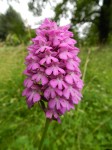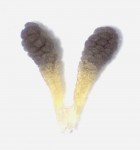The Pyramidal Orchid (Anacamptis pyramidalis), see image 1, has been found on campus (2012), near the NNE end of the Chemistry building. This is a rare sight on the Whiteknights campus, of what is one of the more visible, common and identifiable orchids found in the UK, and shows the species is having a good year, according to botanists at the university and Plantlife. I have seen swathes of 50+ along the A329 motorway embankments. As of 2012, there had only been one other sighting of the species on campus, in the grasslands to the southwest side of Whiteknights lake.
A. pyramidalis is found throughout England, becoming scarcer further north, and is only found on a few of the westerly islands in Scotland, where it is absent from most of the mainland, see NBN maps. Across the English Channel, this orchid can be found throughout Europe, as well as being found east to the Caucasus Mountains, South into to North Africa i.e Morocco, and into Arabia, as far as Iran. According to Plantlife, it was once a flower associated with chalk and limestone grasslands, such places tend to be nutrient poor and alkaline, supporting a wide range of forbs (herbaceous plants). This supports observations of the orchid on sand dunes and in Meadows. In the 21st century however, with major disturbance events in the UK countryside, it has adapted to motorway embankments to canals, suggesting the plant also prefers areas having suffered some disturbance and are well-drained. The species however is threatened in all countries, by changes in management practices i.e. the cutting of grasslands/grazing regime/nutrient enrichment and factors such as trampling by people, and pollution of the soil.
- Image 1 Pyramidal Orchid (Anacamptis pyramidalis) in full bloom © Justin Groves The University of Reading
- Image 2 Pyramidal Orchid (Anacamptis pyramidalis) showing remains of basal rosette of leaves © Justin Groves The University of Reading
- Image 3 Pyramidal Orchid (Anacamptis pyramidalis) showing leaves wrapping around stem © Justin Groves The University of Reading
- Image 4 Pyramidal orchid showing the spur and twisted ovary © Justin Groves The University of Reading
- Image 5 Pyramidal Orchid (Anacamptis pyramidalis) showing sepals and pollinia © Justin Groves The University of Reading
- Image 6 Pyramidal orchid without the pollinia © Justin Groves The University of Reading
- Image 7 Pyramidal orchid (Anacamptis pyramidalis) showing the pollinia © Justin Groves The University of Reading
- Image 8 Pyramidal Orchid (Anacamptis pyramidalis) with the pollinia © Justin Groves The University of Reading
The Pyramidal Orchid is within the genus Anacamptis, in Greek meaning to bend backwards, referring to the anther, and is found within the family Orchidaceae. Orchidaceae are monocots, defined by usually having one seed leaf on germination and parallel leaf veins, and has the typical orchid flower of six tepals, one forming the labellum. As a whole, Orchidaceae are one of the 3 largest plants families, along with Fabaceae and Asteraceae.
Anacamptis pyrimidalis is a long-lived perennial, taking in some cases many years to develop to reproductive age, it is also capable of staying dormant for many years, waiting for the right conditions to flower. The species flowers from May – July, and can reach heights of up to 60cm, although approximately 20-30cm, is somewhat more common in the English countryside. The plant shape is characterised by a rosette of lanceolate green leaves, see image 2. On maturity, a central flower spike is produced, that has smaller tapering leaves that wrap round the stem see image 3, in a spiral arrangement. At the top of this stem one finds the pyramidally shaped inflorescence, most obvious before all the flowers have opened. The inflorescence is approximately 2-5cm in height. The flowers come in a range of shades from White (rare, RHS codeNN155 C), pink (RHS 73 B) to deep pink (RHS code 67 A) however, most common is Britain, is the rose-pink colour (RHS code 68 A). The flowers are uniform in their colour and have no dark spots etc, typically being 20mm in length, including the spur see image 4. The flower parts are always in multiple of three. To begin the flowers are always upside down, this is a result of the flower buds twisting as they open, which also twists the tripartite ovary at the same time, see image 4. Each flower is beautiful in design, firstly you have the three sepals, one is above the petals, the other two to the sides see image 5. On the sepals opening, the orchid exposes three petals that as a beginner, will look like 5, due to the lobes on the lower petal see image 5. The two upper petals then form a canopy over the basal petal, as you can see from image 5 and the basal petal (labellum) is large, with three lobes and at the back forms the spur, containing no nectar, as the species has been found by Kowalkowska et al. to be deceitful, and does not reward its pollinators. The deception is excellent, as it fools insects though fragrance secretions from the flowers (imitation nectar). At the centre of the lower petal, there are two ridges to form a half funnel, that guide an insects proboscis past the stigmas, to touch the bursicle, exposing the viscidium, that have pollinia attached. Effectively, the stamens, anther, style and stigmas are all fused into one structure, called the column, and have become highly modified to hold the pollinia, see image 6 (with pollinia removed), and 7 (with pollinia in place). When the bursicle is touched, a chain reaction begins to rapidly attach the pollinia to the insects proboscis, this involves the viscidium being exposed and the air drying and curling it around the insects proboscis, gluing itself in place. As the insect reverses the two pollinia are attached and pulled out of the flower see image 8. The insect therefore removes all of the orchid’s pollen in one go. At first, these pollinia stand erect on the proboscis, but as the viscidium dries further, it tilts forward, allowing pollination of subsequent flowers, so that it can reach the stigma. Self pollination is prevented by the arrangement of the pollinia after attachment.
The Pyramidal Orchid, as with all UK species, has a symbiotic relationship with mycorrhizal fungi, as discussed in a paper on conservation of orchids by Clements et al., they found 6 fungal isolates for Pyramidal Orchid. However, in lab experiments the mycorrhizae would not germinate its hosts seeds. Such symbiosis are needed to produce an inflorescence and it can take many years for this to happen. Survival in dormancy, is also aided by the orchid feeding on its symbiotic partner, allowing dormancy for a number of years. The orchid seeds have no endosperm (no nutritive coating around the embryo for initial development of the seedling). Therefore, the seed must become infected with its fungal associates (mycorrhizae), for the seeds to germinate and form a protocorm and then rhizoids (root like growths without xylem/phloem), that allow the movement of nutrients and water into the growing structure. At this point, the orchid is totally reliant on the mycorrhizae, especially for carbon. This symbiosis then stays for the life of the plant, whereupon it infects the cells of the cortex, and is confined to the roots. The plants are also thought to be able to control infection. The Orchid is believed to extract the nutrition through the digestion of the mycorrhizae, of which the chemicals to do so, may even be produced by the mycorrhizae themselves! The mycorrhizae form coils (pelotons), within the hosts cells. The presence of various chemicals then allows the transfer of nutrients between the two organisms. Gene expression in both organisms, is also thought to allow the symbiosis within the orchid cells i.e. the lowering or raising of specific chemicals.
For further information see the following:
Clements, M. A., Muir, H. and Cribb, P. J., 1986. A Preliminary Report on the Symbiotic Germination of European Terrestrial Orchids. Kew Bulletin, 41 (2), pp.437-445
Kowalkowska, A.K., Margonska, H.B., Korieradzka-Kiszkurno, M. and Bohdanowicz, J., 2012. Studies on the ultrastrcuture of a three-spurred fumeauxiana form of Anacamptis pyramidalis. Plant Systematics and Evolution, 298(6), pp. 1025-1035
Kull, T. and Arditti, J., 2002. Orchid Biology: Reviews and Perspectives, VIII. Dordrecht Netherlands: Kluwer Academic Publishers
Please record any sighting of this species on campus in the comments section with the date seen.








